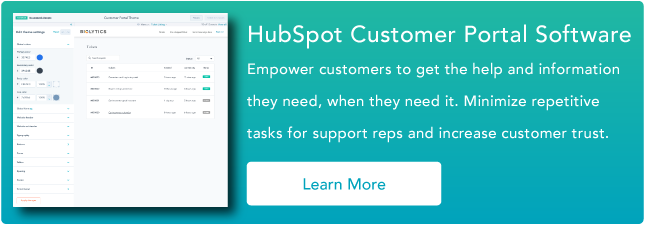Ah, the beauty of self service.
Learn more about what a customer portal is and how to create the optimal self-service portal experience for your customers.
What is a customer portal?
A customer portal — also known as a client portal — provides a home base for your customers to interact with your support team. It's a single entry point where customers can access status updates for their open support requests along with company information, product details, and account history. Customer portals also help service reps better organize and understand customer data.
What is a self-service portal?
A self-service portal gives customers direct access to your business' self-service functions. These include your knowledge base, FAQs, community forum, administrative capabilities, and more. Self-service portals empower customers to complete tasks independently and solve problems without the help of your customer service rep.
Why is a self-service portal important?
According to Statista, 88% of people expect brands or organizations to have a self-service support portal.
In today's world, customers want to be in charge of their service experience. They're looking for fast and easy answers to their questions without having to sit on the phone with a support rep.
Self-service portals give people the tools to resolve issues quickly and independently.
But customers aren't the only reason that self-service portals are important for businesses. The self-service functionality allows people to complete routine tasks — such as password resets and basic product troubleshooting — autonomously.
This means your support team can focus their time and energy on more complex customer requests.
Additional Benefits of Self-Service Portals
- Higher customer satisfaction: Customers have around-the-clock access to the tools they need to use your product or service successfully.
- Increased customer engagement: Customers have a centralized location to build communities within your brand through forums and knowledge sharing.
- Reduced incoming ticket volumes: Self-service portals allow more customers to find their own solutions to common issues rather than submitting a ticket.
- Improved support team efficiencies: Task automation tools for functions like help desk and ticketing systems in your client portal can help streamline your customer service workflow.
What makes a good self-service portal?
A Clean and Simple User Interface
Since self-service portal software is made for your customers, it should be designed for them, too. Your self-service portal should be easy for customers to navigate when trying to accomplish their goals. This requires a straightforward user interface, or UI, and service options that are clear and intuitive.
Good UI design makes sure customers can find the help they're looking for with little to no friction. Be consistent with the colors, fonts, iconography, and other visual treatments on the page. Try to use a minimalist approach, and only focus on the must-have elements for customer success.
You can also customize the portal home page to quickly point customers to common navigation areas, like your FAQs. Or, you can give users the option to personalize their own portal with built-in features.
Either way, a good user experience goes a long way in keeping your customers happy.
Detailed Information and Resources
A well-built self-service portal has a wealth of information and resources. Along with content volume, you should also provide different content types and formats when possible.
A new customer will likely need more hands-on support as they learn how to use your product. Screenshots, videos, and other interactive content can help make how-to articles and detailed instructions easier to follow.
On the other hand, an experienced customer probably doesn't need the same level of support as a newbie. Quick FAQ punch lists or short troubleshooting guides are good to have, too.
If you're not sure what types of information your customers want, ask them. User surveys and customer satisfaction surveys can give you insight into customer needs.
Regular Maintenance and Content Refreshes
Your content is only as good as its upkeep. Chances are you're regularly adding new product offerings or service features to your brand.
Your self-service portal should reflect that.
Customers should be able to go into their portal and find timely, accurate solutions to their problems at any given time. You should be reviewing and refreshing resources —such as knowledge base articles and learning guides —on a routine basis.
It also doesn't hurt to proactively let users know when your product information was last updated.
Customer Self-Service Portal Features
Knowledge Base
A comprehensive knowledge base is an important feature to include in any self-service portal.
The knowledge base acts as a customer service library with information about your product, service, and related topics — usually frequently asked questions, or FAQs.
When customers come to their portal, they're likely looking for fast answers to their questions. Your knowledge base should be organized and easily searchable so users can find what they need without contacting a support rep.
Most knowledge bases include:
- FAQs
- Product-related news and articles
- How-to guides
- Step-by-step troubleshooting instructions
Here's a pro tip: When brainstorming areas to cover on your knowledge base, take a look at the support tickets you receive from customers. You can use those topics as your starter content.
And remember, you should always keep an eye on your articles over time to revise information that's inaccurate or outdated.
Community Forum
A community forum is another great self-service capability that can save your customers and your agents time. In this section of your portal, customers help each other by publicly responding to questions and posting solutions.
This can reveal unique workarounds and tips that your team may not be aware of as well as get your customers the answers they desire quickly.
Check out HubSpot's Community for an example of what one of these forums may look like.
Omni-Channel Support
It's important to meet customers on the channels they use the most. And having a customer self-service portal that's only accessible on a desktop is no longer effective.
Omni-channel experiences allow users to access your software on all platforms and devices.
Did you know that over 90% of the global internet population uses a mobile device to go online? This means your portal should be mobile-friendly or accessible through your app.
Another omni-channel best practice is making sure the customer experience is consistent regardless of where they're coming from.
For example: Let's say a customer logs into their self-service portal on their desktop. When they revisit the portal from their phone, the portal should look and function the same. In other words, they should be able to pick up right where they left off.
Task and Workflow Automation
Automation can help create efficiencies within your self-service portal.
On the backend, you can set up workflows for routine processes — such as sending a password reset email to a customer upon request or closing out a ticket in your help desk system.
Automated chat options, like chatbots, are also a great way to facilitate communication with your customers. A chatbot is a conversational tool that lets users engage with self-service options in a live environment without the help of a service rep.
Chatbots can be programmed to answer common questions and point users to relevant information within your portal.
App Integrations
Your internal support processes will become more efficient if your self-service portal can integrate with other apps and systems.
App integrations ensure your data is aligned, updated, and organized across all of the tools you use.
For example: If you already have a knowledge base set up, it would be easier to integrate the existing resource bank into your client portal software — rather than having to transfer all of the content manually.
App integrations allow for easy access to all of your information via one single platform.
Customer Self-Service Portal Software Examples
Here are a few examples of self-service portal software for your business.
HubSpot's Self-Service Portal
Pricing
This feature is only available in premium editions of Service Hub. See the pricing page for more information.
Key Features
With HubSpot, your self-service portal is connected to a shared inbox for easy rep-to-customer ticket conversations. This is also where customers can access your knowledge base.
To further enhance the customer experience, you can choose to brand the portal and personalize it for the individual using it.
And since the shared inbox is also connected with your CRM, you can get rid of duplicate, time-consuming tasks for reps and use automated features — such as workflows — to improve productivity.
Benefits
- Set up your portal without developer resources
- Connect your help desk and shared inbox
- Give access to your knowledge base from within the portal
- Automatically apply your brand colors, fonts, and logo
Freshdesk's Self-Service Solution
Image Source: www.freshdesk.com
Pricing
Freshdesk offers a 21-day free trial with all features. No credit card required. There is a free plan available with basic features. Paid plans range from $15 per agent/month to $79 per agent/month billed annually.
Key Features
Freshdesk allows you to create a self-service portal customized to your most important brand elements.
Through the knowledge base feature, your team and customers have access to your learning articles, product solutions, and instructional workarounds. Plus, you can integrate the email content you send to customers into articles on your knowledge base.
You can also provide a platform for your customers to ask questions and post advice through community forums.
Benefits
- Simplify every customer experience and put customer back in control
- Give agents the tools to proactively anticipate and understand customer needs
- Increase your productivity and speed of service
Zendesk's Help Center
Pricing
Zendesk's plans range in price from $49 per agent/month to $99 per agent/ month billed annually.
Key Features
Customers can submit requests via ticket in the self-service portal. Your team can select specific fields to show on the initial ticket submission form so reps can get the information they need to effectively begin helping a customer.
Zendesk then allows your customers to track activities they care about via one platform including their ticket status. Additionally, they can access new and updated knowledge base content and community forum additions that they made or want to follow.
Benefits
- Provide exceptional customer experiences
- Accelerate growth with a one-stop CRM
- Drive higher productivity and superior ROI
- Integrate with your favorite business apps
Self-service portals do more than just making sure the right size of pants are delivered to your doorstep. Remember our checkout and exchange debacle?
They give you the opportunity to improve the customer experience. And that increases your ability to retain more customers and turn them into loyal brand advocates.
Customer Support















